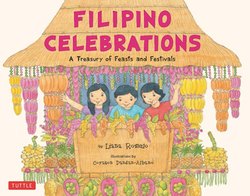Читать книгу Filipino Celebrations - Liana Romulo - Страница 7
На сайте Литреса книга снята с продажи.
ОглавлениеCakes and birthday parties came to the Philippines during the American occupation, as did party hats, confetti, and the practice of singing the Happy Birthday Song. The Filipino way of celebrating birthdays in the old days was quite different. Family and friends prepared to greet the birthday celebrant very early in the morning, before he or she woke up, in a practice called the mañanita. They would sing and bring food to the birthday celebrant.
Pansit represents long life. Just like in Chinese culture, serving noodles at birthday celebrations ensures a long, healthy life for the celebrant.
first birthday, first haircut
A child’s first birthday is considered a big deal, and is celebrated with a party... and a first haircut. In some regions the baby’s parents ask their smartest relative to perform the ritual cutting, so that the baby will love school when he or she grows up.
Games
Kids of all sizes try to grab toys and goodies as the bamboo pabitin is lowered slowly, then suddenly snatched out of reach several times. Colorful banderitas, made from strips of crêpe paper, get in the way and make it a little tougher for kids to grab what they want.
In hampas palayok you need to be blindfolded, then spun around three times. The game master will point you in the general direction of the hanging target, and everyone will cheer you on as you swing hard at it. If you break the clay pot, candies will rain down all around you—and party guests will scamper about trying to grab as much candy as they can.
sack race
In the game luksong sako you have to hop as fast as you can to the finish line in a sack.
A Debut
When a girl turns eighteen her parents get ready to present her to society with a social dance called a debut. Just like in other cultures that practice this tradition, the debutant usually wears a formal gown to the grand party, which is often held at a hotel or banquet hall. The first dance of the evening is always performed by the celebrant and her father.
Our former motherland, Spain, introduced us to the debut tradition, so cotillón is a Spanish word. Eighteen of the debutant’s closest male friends dance in her cotillón, an elegant rehearsed ballroom dance, along with eighteen of her best female friends.
Women and girls most dear to the celebrant then light eighteen candles, one at a time, to symbolize the “light” or guidance they will offer her as she makes her transition into womanhood. Very often the debutant’s mother lights the final candle and says a few words.
Each of the boys presents the debutant with a single rose, usually before the dance.
